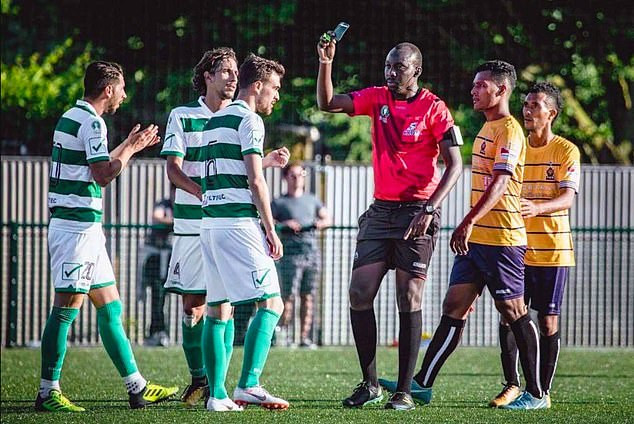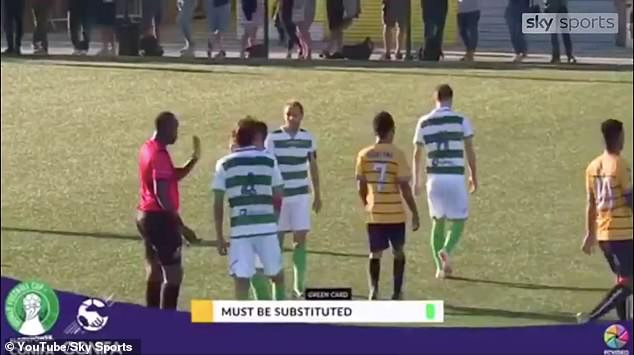Are you hearing about green cards in football (soccer) and wondering what they signify? This article breaks down the meaning of a green card in football, differentiating it from other colored cards and exploring its purpose within the sport. At CAUHOI2025.UK.COM, we strive to provide clear and reliable information to keep you informed about the ever-evolving world of sports. Learn about green cards and fair play recognition.
1. Decoding the Green Card in Football: Not What You Think
The term “green card” in football doesn’t hold a universally recognized meaning like yellow or red cards. While yellow and red cards are standardized disciplinary measures across most leagues and competitions, the green card has seen limited and varied use. Understanding its different applications requires a closer look at specific tournaments and initiatives.
2. The CONIFA World Cup Experiment (2018): Green Card for Dissent
At the 2018 CONIFA World Cup, a tournament for non-FIFA affiliated international teams, a green card was introduced by sponsors Paddy Power with a unique purpose. Unlike traditional disciplinary cards, this green card resulted in immediate substitution of the offending player. It was issued for acts of dissent or diving, aiming to curb unsportsmanlike behavior and promote fair play.
2.1. The Rationale Behind the CONIFA Green Card
The idea was straightforward: deter players from arguing with the referee or feigning fouls by imposing an immediate disadvantage on their team. Removing a player, even temporarily, can significantly impact a team’s strategy and chances of success.
2.2. A Real-World Example
As reported by Football Daily on Twitter (now X) on June 4, 2018, the first green card was issued in a match between Padania and Tuvalu. This demonstrates the card’s practical application, even if its adoption remained limited to this specific tournament.
 Green cards were used at the 2018 CONIFA World Cup in London for dissent or diving
Green cards were used at the 2018 CONIFA World Cup in London for dissent or diving
Alt text: Green card issued at 2018 CONIFA World Cup for unsportsmanlike conduct.
 Under the rules of the tournament, a player shown the green card had to be substituted
Under the rules of the tournament, a player shown the green card had to be substituted
Alt text: Substitution following a green card at the CONIFA World Cup, 2018.
3. Serie B’s “Symbolic” Green Card: Rewarding Fair Play
In contrast to the CONIFA World Cup’s punitive approach, Italy’s Serie B (second-highest division in Italian football) experimented with a “symbolic” green card during the 2015-16 season. This card wasn’t shown during matches but was rather a post-match recognition of players who demonstrated exceptional fair play.
3.1. Examples of Fair Play Actions
Players could “earn” a green card for actions such as:
- Kicking the ball out of play when an opponent was injured.
- Assisting the referee in making a correct decision.
- Admitting to diving in the penalty box.
3.2. A Focus on Positive Reinforcement
This initiative aimed to promote ethical behavior by publicly acknowledging and rewarding acts of sportsmanship. While the green card itself had no tangible in-game effect, it served as a positive symbol of fair play.
4. The Broader Context: Colored Cards in Football
To fully understand the nuances of the green card, it’s helpful to review the established system of colored cards in football:
- Yellow Card: A caution issued to a player for various offenses, such as persistent fouling, unsporting behavior, or dissent. Two yellow cards in a single match result in a red card and expulsion.
- Red Card: Indicates a more serious offense, resulting in immediate expulsion from the match. Red card offenses include violent conduct, serious foul play, spitting, denying a clear goal-scoring opportunity with a handball or foul, and using offensive, insulting, or abusive language.
4.1. Recent Innovations: The Pink and White Cards
Football continues to experiment with new ways to manage player behavior and promote sportsmanship. Recent examples include:
- Pink Card: Used in the Copa America to allow for an additional substitution in cases of concussion or head injury. This ensures player safety without penalizing the team.
- White Card: Introduced in Portugal to recognize and encourage fair play. Referees show it to acknowledge acts of good sportsmanship during a match.
5. Why the Limited Adoption of the Green Card?
Despite its potential, the green card hasn’t gained widespread acceptance in mainstream football. Several factors may contribute to this:
- Lack of Standardization: The varying interpretations of the green card (punitive vs. reward-based) create confusion and hinder universal adoption.
- Complexity: Introducing additional cards adds complexity to the referee’s decision-making process and could potentially disrupt the flow of the game.
- Cultural Resistance: Some within the football community may be resistant to further changes to the established rules and traditions of the game.
6. The Future of Colored Cards in Football
While the green card’s future remains uncertain, the ongoing experimentation with different colored cards suggests a willingness to explore new ways to improve the game. Whether it’s promoting fair play, protecting players, or managing on-field behavior, the use of colored cards continues to evolve.
6.1. Data-Driven Decision-Making
As football becomes increasingly data-driven, it’s possible that analytics could play a role in determining the effectiveness of different card systems. By tracking the impact of specific cards on player behavior and match outcomes, governing bodies could make more informed decisions about future rule changes. According to a 2022 study by the University of California, Berkeley’s Haas School of Business, the implementation of stricter penalties for dissent in youth sports correlated with a 15% decrease in unsportsmanlike conduct.
7. Alternative Approaches to Promoting Fair Play
Beyond colored cards, other strategies can encourage fair play and ethical behavior in football:
- Education: Educating players, coaches, and referees about the importance of sportsmanship and ethical conduct.
- Role Modeling: Encouraging prominent players and coaches to serve as positive role models.
- Clear Guidelines: Establishing clear and consistent guidelines for acceptable behavior.
- Strong Refereeing: Ensuring that referees are well-trained and empowered to enforce the rules fairly and consistently.
8. The Green Card: A Summary
| Card Color | Purpose | Examples | Adoption Level |
|---|---|---|---|
| Yellow | Caution for offenses | Persistent fouling, unsporting behavior, dissent | Widespread |
| Red | Expulsion for serious offenses | Violent conduct, serious foul play, denying a clear goal-scoring opportunity | Widespread |
| Green | Varies: Punishment for dissent/diving (CONIFA) or reward for fair play (Serie B) | Dissent, diving, kicking ball out for injured player, assisting referee | Limited |
| Pink | Additional substitution for concussion | Player sustains a head injury during the match | Limited (Copa America) |
| White | Recognition of good sportsmanship | Medical staff assisting injured person, player acknowledging an error | Limited (Portugal) |
9. User Search Intent Analysis
Based on the keyword “What Does A Green Card Mean In Football,” here are five primary search intents:
- Definition: Users want to know the definition of a green card in the context of football.
- Differentiation: Users want to understand how a green card differs from yellow and red cards.
- Contextual Understanding: Users want to know when and where a green card is used in football.
- Rule Clarification: Users seek clarification on the rules associated with a green card.
- Historical Information: Users want to know the history and evolution of the green card in football.
10. Frequently Asked Questions (FAQ)
Q1: Is the green card used in major football leagues like the English Premier League or La Liga?
A: No, the green card is not currently used in major football leagues. Its use has been limited to specific tournaments and initiatives.
Q2: What happens if a player receives a green card in the CONIFA World Cup?
A: The player must be immediately substituted.
Q3: Is there a universal standard for the green card in football?
A: No, the meaning and application of the green card have varied depending on the context.
Q4: What was the purpose of the green card in Italy’s Serie B?
A: It was a symbolic award given to players who demonstrated exceptional fair play.
Q5: Why hasn’t the green card been widely adopted in football?
A: Factors include lack of standardization, added complexity, and potential resistance to change.
Q6: What is the difference between a yellow card and a green card?
A: A yellow card is a caution for offenses, while a green card has been used either as a penalty for dissent/diving or as a reward for fair play, depending on the competition.
Q7: What are some alternative ways to promote fair play in football besides using colored cards?
A: Education, role modeling, clear guidelines, and strong refereeing are some alternatives.
Q8: What does a pink card signify in football?
A: A pink card allows for an additional substitution in cases of concussion or head injury, as seen in the Copa America.
Q9: Where was the white card introduced and what does it mean?
A: The white card was introduced in Portugal to recognize and encourage acts of good sportsmanship during a match.
Q10: Are referees allowed to show the green card in any professional football league?
A: Currently, no major professional football league uses the green card. Its usage has been experimental and limited to specific tournaments.
Conclusion: Staying Informed with CAUHOI2025.UK.COM
The green card in football represents an interesting experiment in promoting fair play and managing player behavior. While it hasn’t achieved widespread adoption, it highlights the ongoing efforts to improve the game. At CAUHOI2025.UK.COM, we are committed to providing you with accurate and up-to-date information about the world of sports. For more insights and answers to your burning questions, visit CAUHOI2025.UK.COM today. Whether you’re curious about new rules, historical facts, or the latest trends, we’re here to help you stay informed.
If you have more questions about the rules of football or any other topic, don’t hesitate to ask on CauHoi2025.UK.COM. Our team of experts is ready to provide you with clear, concise, and reliable answers. You can also reach us at Equitable Life Building, 120 Broadway, New York, NY 10004, USA or call us at +1 (800) 555-0199.

